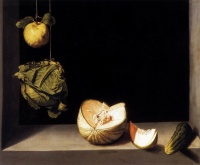Cooking
From The Art and Popular Culture Encyclopedia
(Difference between revisions)
| Revision as of 11:44, 25 December 2012 Jahsonic (Talk | contribs) ← Previous diff |
Current revision Jahsonic (Talk | contribs) |
||
| Line 1: | Line 1: | ||
| + | {| class="toccolours" style="float: left; margin-left: 1em; margin-right: 2em; font-size: 85%; background:#c6dbf7; color:black; width:30em; max-width: 40%;" cellspacing="5" | ||
| + | | style="text-align: left;" | | ||
| + | "[[You are what you eat]]"--''[[The Physiology of Taste]]'' (1825) by Jean Anthelme Brillat-Savarin | ||
| + | |} | ||
| + | |||
| [[Image:Quince, Cabbage, Melon and Cucumber by Juan Sánchez Cotán.jpg|thumb|right|200px|''[[Quince, Cabbage, Melon and Cucumber]]'' (1602) by [[Juan Sánchez Cotán]]]] | [[Image:Quince, Cabbage, Melon and Cucumber by Juan Sánchez Cotán.jpg|thumb|right|200px|''[[Quince, Cabbage, Melon and Cucumber]]'' (1602) by [[Juan Sánchez Cotán]]]] | ||
| {{Template}} | {{Template}} | ||
| - | '''Cooking''' is the process of preparing [[food]], by the analog skills, often with the use of heat. Cooking techniques and ingredients vary widely across the world, reflecting unique environmental, economic, and cultural traditions. Cooks themselves also vary widely in skill and training. Cooking can also occur through chemical reactions without the presence of heat, most notably as in Ceviche, a traditional South American dish where fish is cooked with the acids in lemon or lime juice. Sushi also utilizes a similar chemical reaction between fish and the acidic content of rice glazed with vinegar. | ||
| + | '''Cooking,''' '''cookery,''' or '''culinary arts''' is the [[art]], [[science]], and [[craft]] of using heat to [[Outline of food preparation|prepare food]] for consumption. Cooking techniques and ingredients vary widely, from grilling food over an open fire to using [[electric stove]]s, to [[baking]] in various types of [[oven]]s, reflecting local conditions. | ||
| + | Types of cooking also depend on the skill levels and training of the cooks. Cooking is done both by people in their own dwellings and by professional cooks and chefs in restaurants and other food establishments. | ||
| ==See also== | ==See also== | ||
| - | * [[Carry over cooking]] | + | * [[Carryover cooking]] |
| * [[Control of fire by early humans]] | * [[Control of fire by early humans]] | ||
| - | * [[Cooker (disambiguation)|Cooker]] | + | * [[Cookbook]] |
| + | * [[Cooker]] | ||
| * [[Cooking weights and measures]] | * [[Cooking weights and measures]] | ||
| * [[Cuisine]] | * [[Cuisine]] | ||
| Line 19: | Line 26: | ||
| * [[Food writing]] | * [[Food writing]] | ||
| * [[Foodpairing]] | * [[Foodpairing]] | ||
| - | * [[Gourmet Library and museum]] | + | * [[Gourmet Museum and Library]] |
| * [[High altitude cooking]] | * [[High altitude cooking]] | ||
| * [[International food terms]] | * [[International food terms]] | ||
| - | * [[List of food preparation utensils]] | + | * [[Nutrition]] |
| - | * [[List of recipes]] | + | * [[Recipe]] |
| - | * Nutrition | + | |
| - | * Recipe | + | |
| * [[Scented water]] | * [[Scented water]] | ||
| - | * Spices | + | * [[Spice]]s |
| * [[Staple (cooking)]] | * [[Staple (cooking)]] | ||
| + | * ''[[The Raw and the Cooked]]'' (1964) by Claude Lévi-Strauss | ||
| {{GFDL}} | {{GFDL}} | ||
Current revision
|
"You are what you eat"--The Physiology of Taste (1825) by Jean Anthelme Brillat-Savarin |
|
Related e |
|
Featured: |
Cooking, cookery, or culinary arts is the art, science, and craft of using heat to prepare food for consumption. Cooking techniques and ingredients vary widely, from grilling food over an open fire to using electric stoves, to baking in various types of ovens, reflecting local conditions.
Types of cooking also depend on the skill levels and training of the cooks. Cooking is done both by people in their own dwellings and by professional cooks and chefs in restaurants and other food establishments.
[edit]
See also
- Carryover cooking
- Control of fire by early humans
- Cookbook
- Cooker
- Cooking weights and measures
- Cuisine
- Culinary arts
- Culinary profession
- Cooking school
- Dishwashing
- Food and cooking hygiene
- Food industry
- Food preservation
- Food writing
- Foodpairing
- Gourmet Museum and Library
- High altitude cooking
- International food terms
- Nutrition
- Recipe
- Scented water
- Spices
- Staple (cooking)
- The Raw and the Cooked (1964) by Claude Lévi-Strauss
Unless indicated otherwise, the text in this article is either based on Wikipedia article "Cooking" or another language Wikipedia page thereof used under the terms of the GNU Free Documentation License; or on research by Jahsonic and friends. See Art and Popular Culture's copyright notice.


